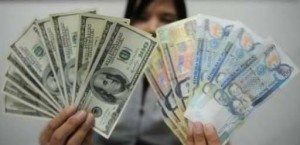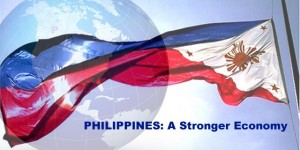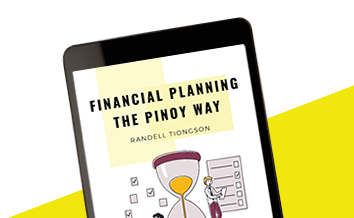2015 Outlook, part 7
By Randell Tiongson on January 20th, 2015
In this installation of the 2015 Outlook series, my friend James Lago of the PCCCI once again gives us his highly valuable views on many factors that will affect 2015 — Economic growth, stock market, US dollars, interest rates, liquidity and more. His outlook will be very helpful as to those who are taking a closer look at their portfolios.
The 2015 Outlook of James Lago
Economy – For 2015, our initial GDP growth forecast range is 6.0% – 6.6%. This baseline assumption is premised on the following growth rates of the major industry groups: industry growing by another 6.5%, services expanding by 6.0% and agriculture posting a 2.5% growth. On the expenditures side, we firmly believe that the substantial decline
in energy prices will translate to increased disposable income which in turn will translate to household spending (HFCE) projected to rise by 5.5% – 6.0%.
The major dividend from lower energy prices is lower inflation. Factoring in our anticipated peso-dollar exchange rate this year, our initial average inflation forecast for the year ranges from 2.1% – 2.5% using the 2006 base year.
PSEi – The bullish trend since its recovery in 2009 remains intact. A fresh historic high of 7,413.62 was achieved as the bull market completed its 6th consecutive year last year.
2015 starts with the leading and trailing relative valuations above its historical averages, as well as the regional average again. The lower energy price benefits will certainly be this year’s major driver. Investors are optimistic that the Philippine economy could post a 6.0% GDP growth rate, at least, for this year. Corporate
earnings will most certainly improve as a result of margin improvement and higher volume sales. Our base case scenario for the PSEi this year is a rise to 7,500 – 7,800. Healthy corrections in between is expected and we see the supports at 6,800 and 6,650.
Peso – US dollar – For this year, with the dollar index firmly above the key level of 90, and as funds flow back into US dollar assets, we see the peso probably depreciating to 46.00 or even 47.00. It will result in a 61.8% to 66.0% retracement of its October 2008 – January 2013 appreciation. On the appreciation side, an appreciation to 44.50 or even 44.00 cannot be discounted within the year as the country will continue to attract both FDI and portfolio inflows given its continued growth prospects and its investment grade rating.
dollar assets, we see the peso probably depreciating to 46.00 or even 47.00. It will result in a 61.8% to 66.0% retracement of its October 2008 – January 2013 appreciation. On the appreciation side, an appreciation to 44.50 or even 44.00 cannot be discounted within the year as the country will continue to attract both FDI and portfolio inflows given its continued growth prospects and its investment grade rating.
Domestic Fixed Income Yields – Real returns on the short-term yields remained negative anew in 2014 despite the sell-off in the latter part of the year. The year ended again with a normal yield curve whose steepness was reduced as the spread between the average short and long-term yields narrowed sharply to 160.30 bps, way below its 250 – 300 bps range.
Excess liquidity and portfolio flows into peso-denominated fixed income securities will most likely keep the continued rise of domestic yields gradual overall. The negative real returns on short-term yields in 2014 might not be absurd compared to the past few years. The flattening of the country’s yield curve, a historical first, is a possible scenario. The spread between the average short-term and long-term yields will most likely move within a 200 – 250 bps range within the year as investors will continue to find ways around the yield levels. The yield curve is also seen to remain essentially normal in 2015 with yields in between 2009 and 2012 yield levels.
Portfolio Strategy – Our overall core equity strategy for this year continues to be anchored on the soundness of a firm’s core business model and its stock’s key relative valuations, PER and PBV, trading at a discount to the PSEi’s averages. Cognizant of the benefits of lower energy prices on consumption spending and the fact that consumer-related or proxy stocks’ relative valuation are trading at a premium to the market’s averages, we chose only those whose premiums are reasonable enough to give investors a better upside potential. As a whole, lower energy prices will be beneficial to most firms by way of improved margins and increased volume sales. Several of the stocks in our short list also have attractive, above market average dividend yields.
Given the potential of a near flattening of the country’s yield curve, driven by the normalization of short-term yields and the low inflation scenario, corporates are seen to continue taking advantage of still affordable medium to long-term yields. We continue to encourage investors to take a serious look at the existing PSE-listed preferred
shares and possible new offerings in 2015 as the yields will remain attractive. For fixed income securities, investors will have to be opportunistic again, taking advantage to purchase, when yields touch attractive levels within the year. It is still best to diversify the fixed income portfolio across various tenors to optimize the portfolio yield. The suggested average tenor or duration of the portfolio must be within the short to middle-tenor ranges as yields on the long dated instruments are not attractive for now.
 Joseph James Lago is the Head of the PCCI Securities Brokers Corp. He has over 2 decades of experience in the investments industry in various capacities. He is also a professor of the De La Salle University Graduate School teaching in Management and Economics. He is a much sought after researcher, economist and analysts. He is a Registered Financial Panner.
Joseph James Lago is the Head of the PCCI Securities Brokers Corp. He has over 2 decades of experience in the investments industry in various capacities. He is also a professor of the De La Salle University Graduate School teaching in Management and Economics. He is a much sought after researcher, economist and analysts. He is a Registered Financial Panner.
2015 Outlook, part 6
By Randell Tiongson on January 16th, 2015
 Is the Philippines now entering a turning point? Is the Philippine economy in a bubble or have we achieve a self-sustaining economic growth? Presenting the views of Business Mirror columnists, investment advocate and seasoned stock market expert John Mangun!
Is the Philippines now entering a turning point? Is the Philippine economy in a bubble or have we achieve a self-sustaining economic growth? Presenting the views of Business Mirror columnists, investment advocate and seasoned stock market expert John Mangun!
The 2015 Outlook of John Mangun
Philippines 2015: a turning point
“A turning point” in literature is defined as the point of highest tension or drama when the solution or climax to the story begins to unfold. That is what the world and the Philippines faces in 2015.
Two events occurred in the financial markets as we closed 2014. The spot price of Brent crude oil hit its lowest price since May 2009. The US Dollar Index, measuring the exchange rate for the US dollar against a basket of currencies, reached its highest level at 90.64 since December 2008.
While we are all looking at the price of crude oil as it affects local gasoline prices, the bigger picture is the general price of most commodities. Virtually every index that measures a broad basket of global commodity prices is trading at or near its 2009 level.
To have this situation can only mean one thing. The global economy is in such bad condition that demand is falling rapidly. If it were only crude oil prices that were falling, then we might be able to make the argument that this is being caused by increased supply. But it is across the board for other critical commodities.
The turning point for the globe is twofold. The first is the uncovering of how bad the global economy really is as the commodity prices fall. The second turning point is how much of the ‘emerging economies’ like Brazil and that class of countries has been dependent on dollars flowing out of the US into their economies.
The same thing happened in the 1997 Asian crisis but the major emerging countries did not account for 50 percent of the global economy like they do now.
The ‘gloom-and-doomers’ have been saying that the Philippine economy is in a bubble and all the growth of the last five years is because of foreign money supporting the economy. I do not believe that. Foreign money as investment coming into this country has been dismal. Remittances from outsourcing companies and from overseas Filipinos are significant. But with domestic sources accounting for 90 percent of all new investment, we are not dependent on the foreigners and their money.
But in the next 12 months we are going to resolve the question if whether or not the Philippines is in a bubble or has finally achieved a self-sustaining growth economy that can handle global economic shocks. I believe we have.
If the Philippine peso can maintain is relative strength and narrow sideways movement in the face of the appreciating dollar, we have finally come to economic maturity. If the interest rate that top corporations must pay on the debt does not widen in relation to the US corporate borrowing rate, we are in great shape.
For stock market watchers, caution is still the strategy. Either we will see a move on the Philippine Stock Exchange Index (PSEi) above 8,500. Alternatively we will see 2015 take the PSEi to below 5,500.
This year will bring new meaning to “It’s more fun in the Philippines”. I’m looking forward to it.
Interest in the stock market first hit John Mangun when he was in his early teens, following the stock price action of  major companies in the daily newspaper long before the computer.
major companies in the daily newspaper long before the computer.
In 1976, Mr. Mangun earned his license as a stock broker on the New York Stock Exchange as well as being licensed and registered for the Options and Commodity markets.
After working for two major Wall Street firms, Mr. Mangun went to England as head of foreign exchange trading for a British asset management company.
Upon his return to the United States, he formed his own investment advisory company administering to the investment needs of corporations and high-net worth individuals.
Mr. Mangun has actively analyzed and traded the Philippine Stock Exchange since 1989, making his first stock purchase (and losing trade) buying shares of San Miguel Corporation on Friday, November 24th, one week before the 1989 coup attempt.
He has been a regular newspaper columnist, writing about the Philippine economy, business, and stock market since 1996. His website is MangunOnMarkets.com
2015 Outlook
By Randell Tiongson on January 6th, 2015
 The Philippine economy has been performing admirably in the last 3 years or so. Most macroeconomic indices, stock market, and many other indicators confirms how the country is faring economically speaking. Spending power of the Pinoy has also gone up as evidenced by more robust trade and higher consumption. As in previous years, the OFW and the BPO sectors have been a big positive factor with regard to economic activity and income building but there has been growth in other sectors too such as manufacturing, services and tourism. Unfortunately, the agriculture sector seems to be a laggard, which is unfortunate because the bulk of our unemployment is agrarian in nature. There are a lot more room for improvement and we just scratching the surface in unlocking the true potentials of this beloved nation. The continuous credit upgrades we have been seeing is a testimony to what we have done and we can do in the future.
The Philippine economy has been performing admirably in the last 3 years or so. Most macroeconomic indices, stock market, and many other indicators confirms how the country is faring economically speaking. Spending power of the Pinoy has also gone up as evidenced by more robust trade and higher consumption. As in previous years, the OFW and the BPO sectors have been a big positive factor with regard to economic activity and income building but there has been growth in other sectors too such as manufacturing, services and tourism. Unfortunately, the agriculture sector seems to be a laggard, which is unfortunate because the bulk of our unemployment is agrarian in nature. There are a lot more room for improvement and we just scratching the surface in unlocking the true potentials of this beloved nation. The continuous credit upgrades we have been seeing is a testimony to what we have done and we can do in the future.
Will 2015 see the same trend of the past years? Many of us believe so. The momentum of the nation is in full gear and we can build on many of our accomplishments. A lot of concerns has been raised with the coming 2016 elections. Clearly, the next administration will be crucial in the sustainability of our growth trajectory. However, we also believe that the reforms instituted by the Aquino administration and the previous ones will play a big role with regard to our economic performance and can safeguard our gains regardless of whoever runs the nation after 2016. In fact, the credit raters feel that our growth will continue beyond 2016 which is why they are giving us the upgrades.
Beyond the OFW remittance, growth in the BPO sector, renewed vigor in the manufacturing, tourism and services sectors, what can we expect from 2015? In 2015 there are exciting things for us to look forward to – the integration of the member-countries of the Association of Southeast Asian Nations and our entering the demographic sweet spot’, among other things.
Asean integration will begin in 2015, and the creation of an economic community will give us many opportunities depending on how we handle ourselves. There are sectors where we will have competitive edge over our neighbors, but there are also sectors where we will be at a disadvantage.
The demographic ’sweet spot’ is the period when the majority of the population of the country reaches its most productive stage: between 15 and 65 years old. Studies have shown that countries that enter this ’sweet spot’ experience the highest economic growth in their history. The experiences of Japan, Korea, Hong Kong, Singapore and China support this theory. Our demographic ’sweet spot’ starts in 2015 and will run for about 30 years or until 2045.
As in previous years, I will be featuring the 2015 Outlook of many experts whom I admire and whose opinions I trust. The views will be coming from a diverse field – from investment analysts, economists and others from the financial services arena. Make sure you visit this site often as I will be putting up their views regularly in the next two weeks.
As we remain bullish with 2015 and the coming years, it is always a good idea to be optimistic but with a dose of caution. Continue to be prudent with the way you handle your money – diversify your wealth and make sure you understand the risks in any endeavor you are getting into.
Further, may we not forget that all these are blessings from the Lord. After all, wealth, and the ability to create wealth come from the Lord; and it is not for our purpose but for His.
———–
You can still avail my books with discounted bundles up to January 7, 2015. Click HERE for details.
 dollar assets, we see the peso probably depreciating to 46.00 or even 47.00. It will result in a 61.8% to 66.0% retracement of its October 2008 – January 2013 appreciation. On the appreciation side, an appreciation to 44.50 or even 44.00 cannot be discounted within the year as the country will continue to attract both FDI and portfolio inflows given its continued growth prospects and its investment grade rating.
dollar assets, we see the peso probably depreciating to 46.00 or even 47.00. It will result in a 61.8% to 66.0% retracement of its October 2008 – January 2013 appreciation. On the appreciation side, an appreciation to 44.50 or even 44.00 cannot be discounted within the year as the country will continue to attract both FDI and portfolio inflows given its continued growth prospects and its investment grade rating. Joseph James Lago is the Head of the PCCI Securities Brokers Corp. He has over 2 decades of experience in the investments industry in various capacities. He is also a professor of the De La Salle University Graduate School teaching in Management and Economics. He is a much sought after researcher, economist and analysts. He is a Registered Financial Panner.
Joseph James Lago is the Head of the PCCI Securities Brokers Corp. He has over 2 decades of experience in the investments industry in various capacities. He is also a professor of the De La Salle University Graduate School teaching in Management and Economics. He is a much sought after researcher, economist and analysts. He is a Registered Financial Panner.



